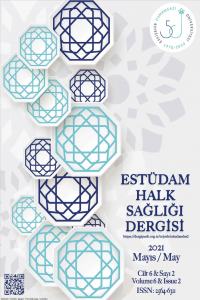Kapsamlı ağız ve diş sağlığı okuryazarlığı ölçümüne yönelik yeni bir araç: T-CMOHK
Sağlık okuryazarlığı, ağız ve diş sağlığı, güvenilirlik ve geçerlilik, toplum ağız ve diş sağlığı
A NEW CONCEPTUAL ORAL HEALTH LITERACY INSTRUMENT IN TURKISH: T-CMOHK
___
- 1. Peterson PE. Global policy for improvement of oral health in the 21st century-implications to oral health research of World Health Assembly 2007, World Health Organization. Community Dent Oral Epidemiol. 2008;37:1-8. doi:10.1111/j.1600-0528.2008.00448.
- 2. National Institute of Dental and Craniofacial Research. The invisible barrier: literacy and its relationship with oral health. A report of a workgroup sponsored by NIDCR, USPHS, DHHS. Journal of Public Health Dentistry. J Public Health Dent. 2005;65(3):174-82. doi: 10.1111/j.1752-7325.2005.tb02808.
- 3. Macek MD, Haynes D, Wells W, Bauer-Leffler S, Cotten PA, Parker RM. Measuring conceptual health knowledge in the context of oral health literacy: preliminary results. J Public Health Dent. 2010;70(3):197-204. Available from: 10.1111/j.1752-7325.2010.00165.x.
- 4. Baskaradoss JK. Relationship between oral health literacy and oral health status. BMC Oral Health. 2018;18:172. doi: 10.1186/s12903-018-0640-1.
- 5. Jagan P, Fareed N, Battur H, Khanagar S, Manohar B. Conceptual knowledge of oral health among school teachers in South India. Eur J Dent. 2018;12(1):43-8. doi: 10.4103/ejd.ejd9317.
- 6. Patino D, McQuistan MR, Qian F, Hernandez M, Weber-Gasparoni K, Macek MD. Oral health knowledge levels of Hispanics in Iowa. J Am Dent Assoc. 2018;149(12):1038-48. http://doi.org/10.1016/j.adaj.2018.07.023.
- 7. Sabbahi DA, Lawrence HP, Limeback H, Rootman I. Development and evaluation of an oral health literacy instrument for adults. Community Dent Oral Epidemiol. 2009;37(5):451-62. doi: 10.1111/j.1600-0528.2009.00490.
- 8. Sistani MMN, Montazeri A, Yazdani R, Murtomaa H. New oral health literacy instrument for public health: development and pilot testing. J Investig Clin Dent. 2013;4:1-9. doi: 10.1111/jicd.12042.
- 9. Ueno M, Takeuchi S, Oshiro A, Kawaguchi Y. Relationship between oral health literacy and oral health behaviors and clinical status in Japanese adults. J Dent Sci. 2013;8:170-6. doi: 10.1016/j.jds.2012.09.012.
- 10. McQuistan MR, Qasim A, Shao C, Straub-Morarend CL, Macek MD. Oral health knowledge among elderly patients. J Am Dent Assoc. 2015;146(1):17-26. doi: 10.1016/j.adaj.2014.10.002.
- 11. Holtzman JS, Atchison KA, Macek MD, Markovic D. Oral health literacy and measures of periodontal disease. J Periodontol. 2017;88(1):78-88. doi:10.1902/jop.2016.160203.
- 12. Peker K, Kose TE, Guray B, Uysal O, Erdem TL. Reliability and validity of the Turkish version of the rapid estimate of adult literacy in dentistry (TREALD-30). Acta Odontol Scand. 2017;75(3):198-207. doi: 10.1080/00016357.2016.1278079.
- 13. Macek MD, Atchison KA, Watson MR, Holtzman J, Wells W, Braun B, et al. Assessing health literacy and oral health: preliminary results of a multi-site investigation. J Public Health Dent. 2016;76(4):303-13. doi:10.1111/jphd.12156.
- 14. International Test Commission (2017). The ITC Guidelines for Translating and Adapting Tests (2nd ed.) www.InTestCom.org. Available from: https://www.intestcom.org/files/guidelinetestadaptation2ed.pdf
- 15. World Health Organization. Process of translation and adaptation of instruments[Internet]. 2020 [cited 2020 September 5]. Available from: https://www.who.int/substance_abuse/research_tools/translation/en/
- 16. Polit DF, Beck CT. The content validity index: are you sure you know what's being reported? Critique and recommendations. Res Nurs Health. 2006;29(5):489-97. doi:10.1002/nur.20147.
- 17. Yong AG, Pearce S. A beginner’s guide to factor analysis: Focusing on exploratory factor analysis. Tutor Quant Methods Pychol 2013;92(2):79-94. doi: 10.20982/tqmp.09.2.p079.
- 18. Pearson RH, Mundfrom DJ. Recommended sample size for conducting exploratory factor analysis on dichotomous data. J Mod Appl Stat Methods. 2010;9(2):359-68. doi: 10.22237/jmasm/1288584240.
- 19. Vaske JJ, Beaman J, Sponarski CC. Rethinking internal consistency in Cronbach’s Alpha. Leis Sci. 2017;39(2):163-73. doi: 10.1080/01490400.2015.1127189.
- 20. Matlock-Hetzel S. Basic concepts in item and test analysis. paper presented at the annual meeting of the southwest educational research association, Austin; 1997.
- 21. Fabrigar LR, Wegener DT, MacCallum RC, Strahan EJ. Evaluating the use of exploratory factor analysis in psychological research. Psychol Methods. 1999;4:272-99. doi: 10.1037/1082-989X.4.3.272.
- 22. Hooper D, Coughlan J, Mullen MR. Structural equation modelling: guidelines for determining model fit. electron j bus res methods. 2008;6(1):53-60. doi: 10.21427/ D7CF7R.
- ISSN: 2564-6311
- Yayın Aralığı: Yılda 3 Sayı
- Başlangıç: 2016
- Yayıncı: Eskişehir Osmangazi Üniversitesi
YAŞAM BOYU GÖZ SAĞLIĞI: “2020 VİZYONU: GÖRME HAKKI”
İsmail ÇEVİK, Harun ÇAKMAK, Özge ÇELİK, Pınar OKYAY
Zeynep ALBAYRAK YAMAN, Egemen ÜNAL
ÜREME ÇAĞINDAKİ MAVİ YAKALI KADIN İŞÇİLERDE ANEMİ: OTOMOTİV SEKTÖRÜ ÖRNEĞİ
Alpaslan TÜRKKAN, Bülent ASLANHAN, Nazan DEMİRALP, Ümit ÖZDEDE, Kayıhan PALA
Tülin ÇOBAN, Bahar DOĞAN, Duygu KAVAKLI, Ali Can KORKMAZ, Büşra BAHADIR, Fahriye HAS AKDAĞ, Ayşegül DENİZ, Çağla BANKO BAL, Tülay İLHAN İYİ, Tülin GULER YILDIZ, Figen TURAN, Aysel ESEN ÇOBAN, Mübeccel GÖNEN
İstanbul’daki kutanöz layşmanyazis olgularının klinik ve epidemiyolojik özellikleri
Neşe YAKŞİ, Hatice İKİIŞIK, Abdullah Emre GÜNER, Işıl MARAL
Meryem BASATEMÜR, Gülsen GÜNEŞ
Kapsamlı ağız ve diş sağlığı okuryazarlığı ölçümüne yönelik yeni bir araç: T-CMOHK
Özlem EKMEKCİ GÜNER, Nesrin ÇİLİNGİROĞLU
Yaşlı bireylerde malnütrisyon/malnütrisyon riski sıklığı ve etkileyen faktörler
